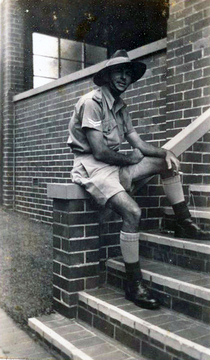STEPHENS, John Joseph
| Service Number: | NX93918 |
|---|---|
| Enlisted: | 30 March 1942 |
| Last Rank: | Staff Sergeant |
| Last Unit: | General / Motor Transport Company/ies (WW2) |
| Born: | Bondi, New South Wales, Australia, 24 April 1908 |
| Home Town: | Not yet discovered |
| Schooling: | Not yet discovered |
| Occupation: | Not yet discovered |
| Died: | Cardiac arrest. Ischaemic heart disease. Pulmonary fibrosis, Darlinghurst, New South Wales, Australia, date not yet discovered |
| Cemetery: | Not yet discovered |
| Memorials: |
World War 2 Service
| 30 Mar 1942: | Enlisted Australian Military Forces (WW2) , Staff Sergeant, NX93918, General / Motor Transport Company/ies (WW2) | |
|---|---|---|
| 27 Feb 1946: | Discharged Australian Military Forces (WW2) , Staff Sergeant, NX93918, General / Motor Transport Company/ies (WW2) |
Joined the AIF
A memoir from John Joseph Stephens personal papers & letters.
During 1939 the Second World War had started and the same scenes of soldiers marching of were enacted. Thousands enlisted in the forces and, after hasty training in camps throughout Australia, were sent overseas - The Second A.I.F. Another army was built up for Home Defence. This was built onto the Citizens Military Forces which had been training voluntarily over the years. As they were not to be sent overseas these people were given the name of Chocolate Soldiers ( Chocko's) by the AIF. Membership of the latter became compulsory for all able-bodied men under a system of marks for single men, married or family men. Many were not called up if they were working in essential services. In 1942 men with a wife and one child were called to join. As soon as my call came I went to the Recruiting Depot in Martin Place, Sydney and joined the AIF. I did not like the thought of going back into the Navy and being down in the bowels of some ship to be shelled or torpedoed.
After a short spell in Sydney Showground, where I was fitted out with army clothes, rifle, kit-bag, blankets etc. we went to Bathurst camp. Here we received our basic training in an Infantry Battalion - rifle drill, bayonet and unarmed combat practice, drilling and long-route marches carrying rifle and full packs for ten miles or more. A cousin, much younger than most of us, put us through physical training - doing push-ups etc. in the early mornings when the ground was frost covered. Being about 34 years old and having led a much easier life I found the going tough. When the opportunity came for a number of us to change over to Transport I was quick to jump at the new job. So long as we were able to start up a truck and get it to move we were accepted. I tried out on an old Albion with seven gears which I had never driven previously but managed to go.
Presently the new drivers were told that they were being transferred to the C.A.M.T.C. Nobody could tell was what this was and, as the Middle East conflict was under way, assumed it to be a Camel Corps or something like that. Soon we were sent to Ingleburn for some further training prior to mobilisation. The Japanese subs raided Sydney one night whilst we were there and everyone was required to leave their huts and disperse in the gullies around. I preferred to slip back to bed. Here we learned that CAMTC stood for Central Australian Motor Transport Column. We were given final leave with our families for a few days and then set off by train. Stopped at Royal Park Army Camp in Melbourne. On to Wavell Camp in the Adelaide Showground, to Treowie Camp and then onto the 'Ghan' for the journey via Maree, Oodnadatta and Cowards Springs to Alice Springs. There we were transported to a camp of tents, sent out in trucks to collect loads of small gravel from the dry river-bed ( but it had been raining and the gravel was wet) which we had to spread over the sand inside our tents. On this surface we spread out our water-proof ground sheets and made up our beds of straw filled palliasses.
end.
Submitted 14 September 2023 by Paul Stephens










